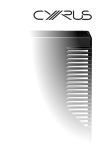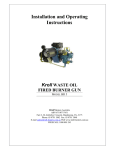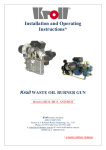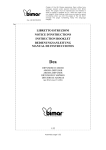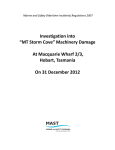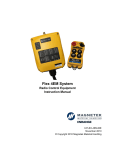Download Linn 500 Solo Stereo Amplifier User Manual
Transcript
Linn Klimax 500 Solo Single Speaker Power Amplifier Each Klimax power amplifier is unique in its manufacture. With its machined and hard-anodised solid alloy casing, the Klimax is a referenced component which is as individual in its finish as it is in its phenomenal pitch-accurate performance. Due to the highest quality of machined finish, it is possible to see that the Klimax’s natural alloy grain structure gives each unit an individual signature that makes ownership a uniquely rewarding experience.LINN customers should accept and understand that there are variances between units.Such variances are the natural result of the metal’s grain structure and indicative of an exceptional product finished individually to the highest standards. Year 2000 Compliance Linn has used all reasonable endeavours to ensure that the software in the products manufactured by it is capable of normal operation before, during and after 1 January 2000 and in respect of past, present and future dates without replacement, alteration or upgrade (“Year 2000 Compliant”). Linn, however, gives no express warranties,representations or undertakings and to the maximum extent permitted hereby excludes any terms, warranties, representations or undertakings implied by law to that effect. Linn cannot give any warranties, representations or undertakings that non Linn software is or will be Year 2000 Compliant or that Linn’s software will be Year 2000 Compliant if used in conjunction with non Linn products,systems or software.The Purchaser,Installer,Retailer or Distributor will be solely responsible for ensuring that Linn’s software will be Year 2000 Compliant when used in conjunction with such non Linn software, systems or products and for any failure if it is not Year 2000 Compliant in such circumstances. Except to the extent implied by law and which by law cannot be excluded, Linn shall not be liable to any party for any costs, claims, losses (including indirect and consequential losses) or liabilities arising from the failure of Linn’s software to be Year 2000 Compliant if used in conjunction with non Linn products, systems or software. Important safety information Explanation of symbols used in this manual and on the product. This symbol is intended to alert the user to the presence of uninsulated dangerous voltages within the enclosure of sufficient magnitude to cause electric shock. This symbol is intended to alert the user to the presence of important maintenance and servicing information in the instruction and service manuals. CAUTION TO REDUCE THE RISK OF ELECTRIC SHOCK, DO NOT REMOVE THE COVER. NO USER SERVICEABLE PARTS INSIDE. REFER SERVICING TO QUALIFIED SERVICE PERSONNEL. WARNING: SHOCK HAZARD.DO NOT OPEN. AVIS: RISQUE DE CHOC ELECTRIQUE.NE PAS OUVRIR. CAUTION: REPLACE FUSE WITH SAME TYPE AND RATING. ATTENTION: UTILISER UN FUSIBLE DE RECHANGE DE MÊME TYPE. DISCONNECT SUPPLY CORD BEFORE CHANGING FUSE. ATTENTION: DEBRANCHER AVANT DE REMPLACER LE FUSIBLE. WARNING TO REDUCE THE RISK OF FIRE OR ELECTRIC SHOCK, DO NOT EXPOSE THIS APPLIANCE TO RAIN OR MOISTURE. MAINSPLUGS This appliance is supplied with a non-rewireable mains plug for the intended country. Replacement mains leads can be obtained from your Linn retailer. Should you need to change the plug, please dispose of it carefully. A plug with bared conductors is dangerous if engaged in a live socket. The Brown wire must be connected to the Live (Line) supply pin. The Blue wire must be connected to the Neutral supply pin. The Green/Yellow wire must be connected to the Earth (Ground) supply pin. Please contact your retailer or a competent electrician if you are in any doubt. i GENERALSAFETYINSTRUCTIONS 1. Read instructions.Read the safety and operating instructions before operating the appliance. 2. Retain instructions. Retain the safety and operating instructions for future reference. 3. Heed warnings. Observe all warnings on the appliance and in the operating instructions. 4. Follow instructions. Follow all operating and use instructions. 5. Water and moisture. Do not use the appliance near water, for example near a bathtub,washbowl, kitchen sink, laundry tub, in a wet basement, or near a swimming pool and the like. 6. Carts and stands. Use only with a cart or stand that is recommended by the manufacturer 6a. An appliance and cart combination should be used with care. Quick stops, excessive force, and uneven surfaces may cause the appliance and cart combination to overturn 7. Wall or ceiling mounting. Mount to a wall or ceiling only as recommended by the manufacturer. 8. Ventilation. Site the appliance so that its location or position does not interfere with its proper ventilation. For example, the appliance should not be situated on a bed, sofa rug, or similar surface that may block the ventilation openings, or placed in a built-in installation such as a bookcase or cabinet that may impede the flow of air through the ventilation openings. 9. Heat. Site the appliance away from heat sources such as radiators, heaters, stoves, or other appliances (including amplifiers) that produce heat. 10. Power sources. Connect the appliance to a power supply only of the type described in the operating instructions or marked on the appliance. 11. Grounding or polarisation. Do not defeat the safety purpose of the polarised or grounding type plug.A polarised plug has two blades with one wider than the other.A grounding type plug has two blades and a third grounding prong.The wide blade or the third prong is provided for your safety.When the provided plug does not fit into your outlet, consult an electrician for replacement of the obsolete outlet. 12. Power cord protection. Route power cords so that they are not likely to be walked on or pinched by items placed upon or against them, paying particular attention to cords at plugs, power sockets, and at the point where they exit from the appliance. 13. Protective attachment plug.As a safety feature the product is equipped with an attachment plug containing overload protection. See the instruction manual about resetting or replacing the plug. Should the plug need replacing, ensure that a replacement is used which has the same overload protection as the original. 14. Cleaning.The product should be cleaned only as recommended by the manufacturer. 15. Power lines.An outdoor antenna should be located away from power lines. 16. Outdoor antenna grounding. If an outdoor antenna is connected to the tuner/receiver,ensure that the antenna system is grounded to provide some protection against voltage surges and static build up. In the USA see article 810 of the National Electrical Code ANSI/NFPA 70 concerning installation requirements. 17. Unplug this apparatus during lightning storms or when unused for long periods of time. 18. Objects and liquid entry.Take care not to let objects or liquids fall into the product. 19. Damage requiring service.The product should be serviced by qualified personnel if: a) The power cord or plug has been damaged. b) Objects or liquid have fallen into the product. c) The product has been exposed to rain. d) The product does not appear to operate normally or exhibits a marked change in operation. e) The product has been dropped or the enclosure damaged. ii 20. Servicing.Don’t attempt to service the product beyond that described in the operating instructions.All other servicing should be referred to qualified service personnel. UKUSERSPLEASEREADTHISIMPORTANTSAFETYINFORMATION Fuse replacement This appliance is fitted with a non-rewireable 13 Amp mains plug.The plug contains a 5 Amp fuse. If the fuse has blown it can be replaced as follows: a) Pull out the red fuse cover/carrier. b) Remove and dispose of the blown fuse. c) Fit a new 5 Amp BS1362 approved fuse into the carrier and push the carrier back into the plug. Always ensure the fuse cover is fitted. If the fuse cover is missing do not use the plug. Contact your Linn retailer to obtain a replacement fuse cover. Fuses are for fire protection and do not protect against electric shock. Mains plug replacement Should your mains plug need replacing and you are competent to do this, proceed as follows. If you are in doubt, contact your Linn retailer or a competent electrician. a) Disconnect the plug from the mains supply. b) Cut off the plug and dispose of it safely. A plug with bared conductors is dangerous if engaged in a live socket. c) Only fit a 13 Amp BS1363A approved plug with a 5 Amp fuse. d) The cable wire colours or a letter will be marked at the connection points of most quality plugs. Attach the wires securely to their respective points.The Brown wire must go to the Live pin, the Blue wire must go to the Neutral pin and the Green/Yellow wire must go to the Earth pin. e) Before replacing the plug top, ensure that the cable restraint is holding the outer sheath of the cable firmly and that the wires are correctly connected. WARNING THIS APPLIANCE MUST BE EARTHED. Replacing the fuse Should the mains fuse blow, replace it only with an equivalent part. The fuse holder is located just below the mains inlet socket. To replace the fuse, disconnect the product from the mains supply. Using a flat blade screwdriver remove and replace the fuse. If the fuse blows a second time there is a fault in the product. Contact your local retailer. Fuse ratings. See specifications section. Mains voltage operating range. See specifications section. Warning!! The power supply may be destroyed if a unit designed for 115V is connected to 230V. iii CE Declaration of Conformity Linn Products Ltd. declare that this product is in conformance with the Low Voltage Directive 73/23/EEC and Electromagnetic Compatibility 89/336/ EEC as amended by 92/31/EEC and 93/68/EEC. The conformity of the designated product with the provisions of Directive number 73/23/EEC (LVD) is proved by full compliance with the following standards. 3. How does Date theof Klimax work? issue Test type Standard number EN60065 1993 General requirements Marking Ionizing Heating under normal conditions Shock hazards under normal operating conditions Insulation requirements Fault conditions Mechanical strength Parts connected to the mains supply Components Terminal devices External flexible cords Electrical connections and mechanical fixings The conformity of the designated product with the provisions of Directive number 89/336/EEC (EMC) is proved by full compliance with the following standards: Standard number Date of issue Test type EN55013 EN55013 EN60555-2 EN60555-3 EN55020 1994 1994 1987 1987 1987 Conducted emissions Absorbed emissions Harmonics Voltage fluctuations Immunity FCC NOTICE NOTE: This equipment has been tested and found to comply with the limits for a Class B digital device, pursuant to Part 15 of the FCC Rules.These limits are designed to provide reasonable protection against harmful interference in a residential installation.This equipment generates, uses and can radiate radio frequency energy and, if not installed and used in accordance with the instructions, may cause harmful interference to radio communications. However, there is no guarantee that interference will not occur in a particular installation. If this equipment does cause harmful interference to radio or television reception, which can be determined by turning the equipment off and on, the user is encouraged to try to correct the interference by one or more of the following measures: - Adjust or relocate the receiving antenna. - Increase the separation between the equipment and receiver. - Connect the equipment into an outlet on a circuit different from that to which the receiver is connected. - Consult the dealer or an experienced radio/TV technician for help. iv Copyright and acknowledgements Copyright © Linn Products Limited. Linn Products Limited, Floors Road, Waterfoot, Glasgow, G76 OEP, Scotland, United Kingdom. All rights reserved. No part of this publication may be reproduced, stored in a retrieval system, or transmitted, in any form or by any means, electronic, mechanical, photocopying, recording, or otherwise, without the prior written permission of the publisher. Printed in the United Kingdom. Klimax is a registered trademark of Linn Products Limited. British Registered Design Application Number 2080160 British Patent Application Number 9900032.5 British Patent Application Number 9812138.7 The information in this manual is furnished for informational use only, is subject to change without notice, and should not be construed as a commitment by Linn Products Limited. Linn Products Limited assumes no responsibility or liability for any errors or inaccuracies that may appear in this manual. Part no: PACK 181 This manual was produced by ROEVIN Management Services Ltd. Altrincham, England. v Contents 1. Introduction ........................................................................................... 2 2. What is it? .............................................................................................. 3 3. How does the Klimax work? ................................................................. 4 What is switch mode? ........................................................................ 5 So what’s the problem? ..................................................................... 6 Some assorted facts ........................................................................ 7 Inside the Klimax .................................................................................. 8 The audio circuitry .............................................................................. 9 Output current and protection ..................................................... 11 4. Installation ........................................................................................... 13 Heat ......................................................................................................... 13 Mains supply ......................................................................................... 15 Signal sensing ...................................................................................... 17 Inputs and Outputs ........................................................................... 18 5. Operation .............................................................................................. 19 6. Specifications ...................................................................................... 20 7. Guarantee and service ....................................................................... 22 8. Index ....................................................................................................... 24 1 1. Introduction Thank you for buying the best power amplifier we have ever made. The result of years of experience, the Klimax uses the latest technology and exemplifies our constant endeavour to make ever better sounding products. We are confident that the compact, elegant design and the exceptional, accurate performance of the Klimax amplifier will give you many years of pleasure. If you wish to know more about this special product, read on. If you just want to use it now, go to the ‘operation’ section. 2 2. What is it? The Klimax is a single speaker power amplifier designed for use in multi amplifier and multi channel audio and audio/video systems. The case is precision machined from two solid sections of aluminium alloy. The machining is done on a computer controlled multi-axis machining centre, with the final cut on the top face made by a Swiss SIP vertical jig borer, the stability and accuracy of which is unequalled. This compact but massive case protects and stabilises the internal electronics and forms the heat exchanger to dissipate the power from the amplifier circuitry. Inside the case are two circuit boards, one on each side of the central heat exchanger. One circuit board constitutes the power supply, the other the audio circuitry. The compact form of the Klimax case reflects our intention to keep the audio signal path as short and simple as possible. This applies as much to a turntable pickup arm as it does to a power amplifier. Applying this rule rigorously results in high density circuitry which generates and receives the absolute minimum level of electrical noise. All our previous power amplifiers have been as compact as the available technology permitted, but in the Klimax we have taken a significant step forward with the new power supply that makes the Klimax possible. If you just want to enjoy your Klimax system right now, jump past all the technical material about to follow and go to the ‘operation’ section. 3 3. How does the Klimax work? In most power amplifiers the power supply comprises a large transformer, a rectifier and reservoir capacitors, often as large as the transformer. The highest performance amplifiers also have voltage regulators which maintain the power supplied to the amplifier circuitry constant, regardless of the input voltage or the output load. The bulk of these components dominates the size of the amplifier and the ‘tightness’ of the audio path, and if voltage regulators are present the power dissipation of the amplifier increases by up to 50%, requiring a bigger heat exchanger. This conventional type of power supply is simple, reliable, tolerant of overload and predictable. On the down side it is very bulky, heavy, slow to respond, inefficient, causes high mains power distortion, can cause electrical and acoustic noise and requires a relatively long and exposed audio path. In the Klimax we use a technology we have been developing and using in our low power products for several years, called ‘switch mode’. This concept is not new; it has been used in computers since the 1960’s, however applying it to audio has always been considered, at best, inappropriate. The potential benefits of switch mode power supply technology are compactness, high efficiency, fast response, good mains input tolerance, good load tolerance, low acoustic noise and with its low material use, environmental friendliness. The potential downsides are electrical noise, high complexity and potentially lower reliability, complex certification requirements, design difficulty and high engineering cost. These have kept switch mode out of most audio equipment. 4 What is switch mode? In a switch mode power supply the incoming mains is filtered then rectified to generate a very high voltage dc (direct current) supply. This is usually about 300 to 350 Volts dc, which is far too high to operate audio circuitry directly, and is still connected directly to the incoming mains supply. Such a high voltage is very dangerous and is one reason why the Klimax case should never be opened by a customer or a non Linn Products employee. This high voltage is chopped up by very fast semiconductor switches and applied to a small transformer which both transforms the voltage to the value needed by the electronic circuitry and provides a safety isolation barrier from the mains supply. The size of a transformer reduces as its operating frequency increases, so a transformer operating at say 60,000 cycles per second is far smaller than one operating at mains frequency of 50 or 60 cycles per second. On the output of the transformer, very fast rectifiers, a small coil and small capacitors filter and convert the high frequency waveform back to dc, ready for the electronic circuitry to use. By controlling the timing of the switches the output voltage can be held constant or varied, as required, without the need for further inefficient voltage regulators. This processing all happens well above the range of human hearing which, in principal, should be good for audio circuitry. 5 So what’s the problem? The first problem is that this is a lot more complicated than a mains transformer (a few kilos of copper and iron), a rectifier and some large capacitors. A switch mode design optimised for minimum part count will still have many tens of parts, most of which are quite delicate but still have to operate reliably in a very electrically hostile environment. We have been designing and building switch mode supplies for our CD players, tuners, preamplifiers and multiroom components for several years and can now make them more reliable than the conventional transformers they replaced. But this takes persistence, thoroughness and a very consistent high quality manufacturing process. The second problem, which is what stops most manufacturers considering switch mode for audio, is the potential high frequency electrical noise, or more precisely, preventing the high frequency signals becoming electrical noise. The scale of the problem is quite daunting. The high frequency signal applied to the transformer if connected to an external antenna would obliterate radio reception for miles around (please don’t try this at home!). This must be controlled and reduced so that it not only meets international legal regulations but it must also not cause any audible or measurable interference with any of the audio circuitry. This does not happen by accident, but takes experience, thorough precision engineering and diligent quality control. Only when all of this is achieved can the potential audio benefits of switch mode start to be revealed and exploited. 6 Some assorted facts The transformer in the Klimax is less than 40mm (1.5 inches) cube. At 50/ 60 Hz it could deliver about 5 Watts. In the Klimax it can deliver 1000 Watts. The reservoir capacitors in the Klimax are about the size of a thimble but give better filtering than ones the size of a beer can used in other very powerful amplifiers. The semiconductor switches turn on and off in about 20nS (20 one thousandth millionths of a second). The overload protection for the switches can detect a potentially destructive condition and protect the switches in less than half a microsecond (half of one millionth of a second). We have patent protection for one of the innovative noise control techniques that are used. 7 Inside the Klimax 8 The audio circuitry At Linn because we strive for continuous improvement in everything we do we use appropriate technologies to achieve our goals. There have been many fine amplifier designs over the history of audio. Some use valves (tubes), some use bipolar transistors, some MOSFETs. Some manufacturers swear by Class A, others by Class AB, one or two by Class D, and many others are somewhere in between. Two designs can use the same components, but achieve completely different results. We believe, and have evidence to support, that what you do with the parts and technology is always much more important than the name of the technology. To illustrate this, our current power amplifier range contains MOSFET, monolithic, discrete and bipolar designs. Our latest monolithic designs sound better than our previous discrete bipolar designs. Our latest bipolar designs have more power and sound better than our earlier monolithic and bipolar designs. So what did we choose for the Klimax? The Klimax audio design was developed from our previous best amplifier, the Klout, which uses completely different circuitry from any of our other amplifiers. Like the Klout, the Klimax also uses all surface mount technology with eight, rather than two ultralinear bipolar output power transistors. There are many other refinements and advances over the Klout design, the result of many years of experience, analysis, experimentation and our simple, consistent method of judging sound quality. We use bipolar output transistors in this design because they are the most appropriate solution. 9 The arguments about the relative merits of tubes, MOSFETS and bipolar devices have filled many technical journals, and needless to say, most are over stated and over simplified to try to win the argument! It’s possible to design a good amplifier using any of the available technologies. Turning it into a great amplifier takes more than just a good argument. In the Klimax we chose bipolars running in Class AB and put in the essential circuitry to take maximum advantage of the inherent linearity of bipolars (unlike MOSFETS), and to manage their potentially slower switch off characteristic. Many MOSFET designs neither adequately linearise the MOSFETs, and in the assumption that ‘they are easy to drive’ don’t put in adequate circuitry to take advantage of their potential switch off speed. However, if we ever decide to make an amplifier above 500 Watts we would most probably use MOSFETs. To run a system of amplifiers of the Klimax power in Class A would heat a house, very expensively, after laying in a high current three phase mains supply to the house. So we chose to use Class AB with the circuitry necessary to control precisely the handover from one power device to the other. To avoid having capacitors in the audio path the Klimax is direct coupled with a dc servo to minimise output offset voltage. 10 Output current and protection A commonly asked question about a power amplifier concerns its maximum output current. There is some good reason behind this question. There is always some trade off between output power, ‘specmanship’, protection and cost in a power amplifier. Output power specification (into 8 Ohms) can be increased simply by increasing the amplifier power supply rails slightly. But what then happens with a 4 Ohm load? Can the amplifier now supply the extra current a 4 Ohm load needs or will the power supplies collapse, or will the amplifier need to protect itself? Short circuit protection can be achieved simply, but at the cost of accidental operation when the loudspeaker load is reactive (almost always) rather than purely resistive (almost never). Output current and ruggedness can be increased with the cost of paralleled output transistors, but can the driver circuitry cope? Hence the interest in output current. However the implication that ‘more is better’ is true only up to a very modest and calculable limit. An electrical load, be it a resistor, capacitor, inductor, heater, a loudspeaker or a hairdryer takes an amount of current dependent on the voltage applied to its terminals, and its operating condition. Although it is not always entirely obvious how much current a load will take with a non-sinusoidal signal (like music) its maximum possible value is easy to calculate, and to monitor in real operation. 11 If an amplifier can provide this amount of current into the specified load while keeping safe and stable and not suddenly dropping its output voltage, it is enough. The load cannot draw any more. The current draw is the result of the voltage applied. If an amplifier protects itself by ‘current limiting’ it will drop its output voltage if too much current is demanded. This is a bad thing for an audio amplifier, but not uncommon. If the current limiting never operates under real conditions it is both a harmless and a good way to protect an audio amplifier. The problem can then be to know if the protection ever triggers or not. This nagging doubt, though often ill-founded, has resulted in some concern (and boasts) about amplifier output current. The Klimax, like all Linn amplifiers, is specified into a 4 Ohm load. We don’t do this to claim a bigger output power, but to show that our amplifiers are intended and fully specified for operation into 4 Ohm loudspeakers. Most Linn loudspeakers have nominally 4 Ohms input impedance. Like all our discrete amplifiers the Klimax has a simple decision making protection circuit. Either the output current is safe or it’s not, in which case the amplifier is shut down instantly for a few seconds. An unsafe output current is defined as a particular level above a certain threshold for a specified length of time, or an instantaneous current above an absolute threshold. If neither of these conditions are violated the amplifier is delivering all the current requested by the load. It’s very easy to tell when our protection circuitry triggers; the amplifier stops. 12 4. Installation The compactness of the Klimax makes it very easy to install and makes possible high power multi-amplifier systems which would be impractical with conventionally designed amplifiers of similar power, because of their size and weight. The unique wall mount system can be used to minimise the intrusion of the audio system into the living space while providing good ventilation, concealing the cabling and showing off the subtle beauty of the Klimax. Heat The Klimax is a very powerful amplifier. Unfortunately, despite the efficiency of the design, it must still dissipate considerable power. It has two methods of cooling; natural convection and forced air convection. Both require an ample supply of air for ventilation. Natural air convection cooling operates for all normal listening conditions by the heated air rising vertically through the central heat exchanger. 13 Restricting the air flow by stacking the amplifiers or putting them in an enclosure may increase the operating temperature until the internal fan is switched on. This should only operate when the amplifier is being worked enthusiastically, or has restricted ventilation. If the ventilation is very restricted the amplifier will shut down until its touchable surface has dropped to a safe value. This is to meet international safety regulations, not to protect the circuitry which can operate reliably with the case very uncomfortably hot to touch. When operating, the fan draws cool air in through the back of the amplifier, and blows it along the heat exchanger until it exits through the front, top and bottom. The amplifier is fully protected against over heating, but this is only for protection and should never operate in normal use, whatever your ‘normal use’ is. If you only ever listen at moderate level, you may never notice the temperature rise above idling. The high thermal mass of the case absorbs short periods of high power input with a slow and low temperature rise and the natural convection through the heat exchanger transfers this to the air. However, the last thing you want is for your audio system to shut down if you are having a party. So always ensure the installation provides plenty of ventilation. 14 Mains supply The Klimax has an automatic internal mains voltage switch. This allows it to operate from 90 Vac to 260 Vac. With a mains supply below 140 Vac two seconds after switching on the amplifier the power supply switches to low range, with a just audible click, and remains there as long as power is applied. For all normal music or AV system operation the actual ‘average’ output power of the Klimax is much less than its maximum rated power. For example, a reasonable listening level needs an average output of about 1 Watt. A very enthusiastic listening level would average about 40 Watts output, per channel. With most loudspeakers this would give an SPL of between 100dBA and 110dBA, which is quite loud. Very few loudspeaker drive units (or crossovers) can stand the maximum continuous output of the Klimax for more than a few seconds. A tweeter can take it for about one tenth of a second, then vapourises. All this means that even though the ‘on the laboratory bench’ measurements could show an input power of almost 1000 Watts with a constant tone input and full rated power, in operation the input power is never anywhere near this level. The Klimax is a high fidelity music playing amplifier, not an industrial servo motor drive amplifier or an arc welder (please contact us if you’re interested in industrial applications). Given adequate ventilation it will operate continuously in any music or AV system at any realistic power level. But with a low mains supply, maximum load and a signal generator on its input, the mains fuse will blow because 100 V and 115 V mains supplies cannot provide enough power to sustain continuous maximum output power. 15 If it really bothers you that you may not simultaneously be able to melt every drive unit in your loudspeaker system, not to mention your ears, then lay in a 230 V mains supply just to provide power to your Klimax system. You may want to consider this for the quality of mains supply rather than only for maximum theoretical power. If you are going to this effort, consider making the new wiring operate at 200 V (Japan) or 230 V (USA). Obviously all mains wiring must be professionally installed to satisfy the appropriate local standards. One of the benefits of the Klimax switch mode power supply is its tolerance to mains supply quality, and the much lower damage it does to the incoming mains supply. Contrary to popular belief, a big audio amplifier does a lot more damage to the mains supply than anything else in your house, and the mains distortion from the power amplifier can cause other audio components grief. Fitting in separate mains wiring spurs for the sources and power amplifiers is not to isolate them from the mains distortion present in the rest of the house; it’s to reduce how much of the mains distortion from the power amplifiers gets into the other audio components in the system! Linn switch mode powered components can actually help to improve the sound of all the other components in the system. 16 Signal sensing The Klimax contains two power supplies. The small, auxiliary one runs as long as the mains switch is on and power is present. It powers circuitry which detects the presence of an audio input signal, and the blue front panel LED. The signal detector is very sensitive but waits about one second before powering up the amplifier to be certain the signal was real, not just noise. When powered up the Klimax will stay on for twenty minutes after the last signal was detected, then revert to standby. The detection threshold has been found over many installations to be a good compromise between sensitivity to low level signals and immunity to noise. However, the residual hiss level from phono preamplifiers at moderate volume settings can be enough to trigger the signal sensor. Mute the preamplifier or turn the volume down after use to prevent this happening. If there is audible hum from the loudspeakers then you may have enough noise present to trigger the signal sensor. Always try to eliminate the source of the hum, as this is essential for a system to sound its best. 17 Inputs and Outputs The Klimax has both single ended and balanced inputs, selected by a switch on the back panel. Use the appropriate one to suit your choice of preamplifier and cabling. LEDs indicate which input is selected. Both signals are echoed out the single ended ‘line out’ socket to enable daisy chaining of amplifiers. This switch does not directly pass the audio signal but instead sends a control signal to distortionless solid state switches.The standard output connectors are two Neutrik 4 contact speaker sockets. They each have two ‘hot’ and two ‘cold’ connections making it easy to connect two speaker cables per connector. If you wish to run individual speaker cables to a four way speaker, use all four connections. All connections are identical and connected directly to the amplifier output. The Neutrik part was chosen for its high quality and connection integrity, compactness and international safety approvals. Please contact us if you wish an alternative type of loudspeaker connection. 18 5. Operation This is the easiest bit. The blue light will flash for a few seconds when power is first applied, then remain dimmed with the Klimax in standby mode. When a signal is detected the light brightens up as the main power supply and amplifier are enabled. If the amplifier needs to protect itself it will shut down entirely for a few seconds and flash the light. There is no half way current limiting; the amplifier can either do what is required of it or it will shut down entirely. The amplifier will revert to standby 10 minutes after the input signal is removed. To operate the Klimax, select a source on your preamp, wait a couple of seconds for the Klimax to power up, then sit back and enjoy it. We wish you many happy years of listening pleasure. From the Linn Klimax team. 19 6. Specifications General Dimensions ................................................................. V350mm W x 355mm L x 60mm H. Weight .......................................................................... 9 Kg Protection: Fuse rating .................................................................. T6.3A Mains input range ..................................................... 90Vac - 126Vac 200Vac - 253Vac @50/60Hz Maximum input power 900W Typical operating input power ................................ 39W Standby power ........................................................... 3W Amplifier specification Input connectors: Single ended (switch position in) ......................... WBTphono socket Balanced (switch position out) ............................ XLR socket Pin connections: Phono ...................... Inner: Hot Outer: Cold XLR .......................... Pin 1: 0V Pin 2: Hot Pin 3: Cold Gain: Single ended ................................................................ 28.6dB Balanced ...................................................................... 22.6dB 20 Input impedance: Single ended ................................................................ 7k6 Ohms Balanced ...................................................................... 7k6 Ohms Input level for clipping: Balanced ...................................................................... 3.34 Vrms Single ended ................................................................ 1.67 Vrms Signal sensing threshold ........................................ >150uV Output connectors: Standard ..................................................................... Neutrik Optional ........................................................................ Binding posts Output power ............................................................ 500W rms into 4 Ohms 290W rms into 8 Ohms Load tolerance .......................................................... Unconditionally stable into all loudspeaker loads Harmonic distortion .................................................... <0.02% Frequency response ................................................ 2Hz - 60KHz (-3dB) Peak output voltage ...................................................... 70V Options and accessories: Wall mount system Active crossover system Binding post output terminals 21 7. Guarantee and service This product is guaranteed under the conditions which apply in the Country of purchase. In addition to any statutory rights the customer may have, we undertake to replace any parts which have failed due to faulty manufacture. To help us, please ask your Linn retailer about the Linn warranty scheme in operation in your country. In the UK and other markets, extended warranty is offered to customers who register their purchase with Linn. A registration card can be obtained from your Linn retailer and should be stamped by them. This will also enable you to receive the Linn RECORD newsletter and details of hi-fi and music available from Linn. Warning Refer all enquiries to authorised Linn retailers only. Unauthorised servicing or dismantling of the product invalidates the manufacturer’s warranty. If you are in any doubt, please contact your nearest Linn retailer. For information on your nearest Linn retailer, contact the Linn factory in Scotland or your national distributor. Important 1 Please keep a copy of the sales receipt to establish the purchase date of the product. 2 Please ensure that your equipment is insured by you during any transit or shipment for repair. 22 For technical support and product queries/information: Our address is: LINN Products Limited Floors Road Waterfoot Eaglesham Glasgow G76 OEP Scotland Telephone: 44-(0)-141 307 7777 UK Helpline: 0500-888909 E-mail: [email protected] Facsimile: 44-(0)-141-644-4262 Website: http://www.linn.co.uk/linn America: LINN Inc. 4540 Southside Blvd. Jacksonville Florida FL 32216 Telephone : 00 19 04645 5254 Germany: LINN Deutschland GmbH Albert Einstein Ring 19, Hambourg, 22761 Telephone : 00 49 40890 6600 23 8. Index A M Acknowledgements ................................................... v Assorted facts ......................................................... 7 Audio circuitry ...........................................................9 Mains plug replacement ......................................... iii Mains plugs ................................................................. i Mains supply ............................................................ 15 C O Copyright ..................................................................... v Current limiting ....................................................... 12 Operation .................................................................. 19 Options and accessories ..................................... 21 Output connectors ................................................ 21 Output current .........................................................11 Output power ........................................................... 21 Outputs ..................................................................... 18 D Dimensions .............................................................. 20 F Fuse replacement .....................................................iii P G Part number ................................................................v Peak output voltage ............................................... 21 Protection ........................................................... 11, 20 Gain ........................................................................... 20 General description ................................................. 3 General safety instructions .................................. ii Guarantee ............................................................... 22 Heat ........................................................................... 13 How the Klimax works ............................................. 4 Safety information ................................................... i Signal sensing .......................................................... 17 Specifications ........................................................ 20 Switch mode .............................................................. 5 Symbols ........................................................................ i I T H Input connectors ................................................... 20 Input impedance .................................................... 20 Input level for clipping ........................................... 21 Inputs ......................................................................... 18 Inside the Klimax ..................................................... 8 Installation ............................................................... 13 Introduction ............................................................... 2 24 S Technical support .................................................. 23 W Weight ....................................................................... 20 Linn Klimax 500 Solo



































